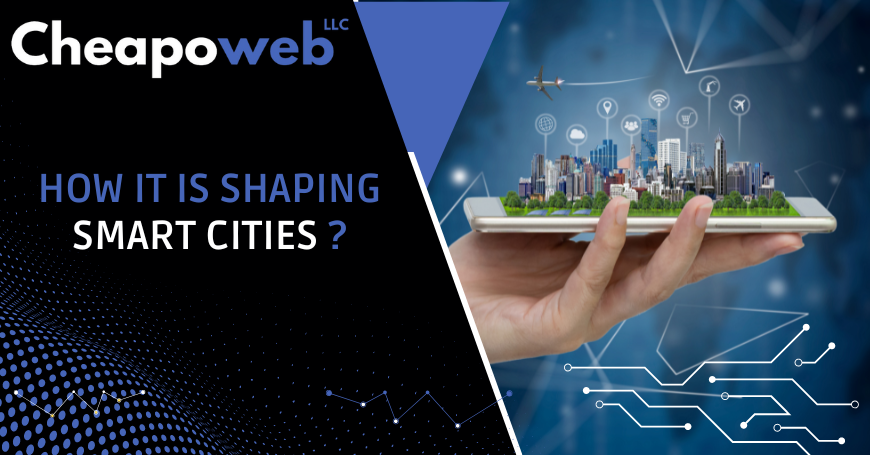How smart is your home? If it is like mine, then it is smarter than 5 or 10 years ago. The reason is that now in our house there are modern devices, smart thermostats, smart speakers, and smart light bulbs. But the trend of intelligent places extends far beyond our homes. All around the world, complete cities have evolved smartly.
What are smart cities IT and why do we need them?
Smart cities IT take advantage of technology to increase efficiency, quality of services, and lives of citizens. From power distribution transport systems, street lights, and even rubbish collection, anything can be covered by smart city initiatives.
The idea is to make life easier for the people who live and work in cities by maximizing the use of resources by using data and technology. More and more people are living in the city, and the UN predicts that in 2050 about 68 percent of people in the world will live in the city.
And that means our cities are facing growing environmental, societal, and economic challenges. By improving cities, we can control some of these challenges and make them better places to live.
One report by McKinsey Global Institute found that smart city IT can make more useful key quality-of-life indicators, such as daily commute, health problems, and crime incidents by 10 to 30 percent.
All this is possible thanks to a perfect storm of technology trends, that trends allow us to make places in which humans and technology can interact more in connected, intelligent, and automated ways. Combined with advances this type of technology changes the world and how we live in it, and our cities are also no exception.
-
Keeping traffic flowing:
Traffic is an issue for many resident’s lives, but technology provides some advantageous solutions. IT Infrastructure smart cities can fix public transport issues to be adjusted in real-time according to demand and intelligent traffic light systems can be used to improve overcrowding.
In Chean’s city, Hangzhou, based on AI smart city brain supported by IT Infrastructure smart cities have helped to reduce traffic jams by 15 percent.
-
Using city resources more efficiently
Mobile and broadband company Telefonica has been heavily investing in IT Infrastructure smart cities in its home country Spain. For example, sensors are attached to refuse the reporting of containers, and how much they are full in real-time. That means refuse collectors don’t have to waste time traveling only to half-full bins.
This allows key performance indicators too closely of the bottom-step impact to be tied. Such as how many bins are near to overflow and will not be emptied in the next few hours. This approach is enabled through IT Infrastructure smart cities is far more significant than estimating abstract factors like how many garbage collecting trucks are outside on the road.
-
Improving energy efficiency:
In addition to investing in clean energy resources in smart cities IT, also used technology to reduce energy consumption and to closely monitor real-time energy use. For example, in Amsterdam, homes are being furnished with smart energy which is designed to motivate minimum use of energy.
Similarly, the city of Schenectady, New York is upgrading its street lights with LED technology, which integrates through IT infrastructure based on real-time data that can be adjusted and dimmed in the smart cities.
-
Making cities safer
Due to the vast spread of Wi-Fi connectivity, IoT technology, and CCTV cameras, IT Infrastructure smart cities are qualified to improve the security of citizens and boost incident response times through infrastructure.
In New Orleans, for example, the analysis of Bourbon Street’s real-time video data is done by IT infrastructure smart cities to better track and allocate resources on the ground, improving public safety.
-
Encouraging greater collaboration with citizens
One of the interesting things about technology is that it predicts humans for more involvement. In common examples, apps are included that allow cities to report about local issues easily or community networking platforms that allow neighbors to connect and share resources.
In another example, local environmental data can be collected by residents which is encouraged by a low-cost environmental testing kit. Smart citizen kits can be placed in locations like balconies and windowsills to gather local environmental data including air and noise pollution. Data will be streamed on online platforms.
In conclusion, information technology plays an important role in shaping smart cities by driving revolution, effectiveness, and maintainability. IT allows cities to improve resources, boost public services, and enhance the quality of life for people with the help of the adoption of IoT devices, AI, big data, and cloud computing. It advances the connection across various city sectors, such as transportation, energy, and healthcare. Smart cities are becoming additional adjustable, durable, and capable of addressing the difficult challenges of development, eventually, creating more maintainable and comfortable environments for future generations.



